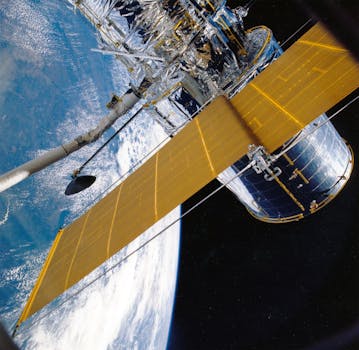From Geostationary to Low Earth Orbit: The Evolution of Satellite Telecommunications in 2023
The satellite telecommunications industry has undergone significant changes in recent years, with a shift from geostationary to low Earth orbit satellites. This article explores the evolution of satellite telecommunications in 2023, including the benefits and challenges of low Earth orbit satellites.

From Geostationary to Low Earth Orbit: The Evolution of Satellite Telecommunications in 2023
Satellite Telecommunications
Satellite Telecommunications has revolutionized the way we communicate, enabling global connectivity and facilitating the exchange of information across the globe. The industry has undergone significant changes in recent years, with a shift from geostationary to low Earth orbit satellites. This shift has been driven by advances in technology, changes in consumer demand, and the need for more efficient and cost-effective solutions.
The traditional geostationary satellite has been the backbone of the satellite telecommunications industry for decades. These satellites are placed in a geostationary orbit, approximately 36,000 kilometers above the equator, and remain stationary relative to a fixed point on the Earth’s surface. Geostationary satellites have been used for a variety of applications, including television broadcasting, telecommunications, and weather forecasting.
Low Earth Orbit Satellites
However, geostationary satellites have some limitations. They are expensive to launch and maintain, and have limited capacity and flexibility. In recent years, there has been a shift towards low Earth orbit (LEO) satellites, which orbit the Earth at an altitude of approximately 160 to 2,000 kilometers. LEO satellites have several advantages over geostationary satellites, including lower launch costs, faster data transfer rates, and greater flexibility.
LEO satellites are being used for a variety of applications, including satellite broadband, Earth observation, and satellite navigation. They are also being used to provide connectivity to remote and underserved areas, where traditional telecommunications infrastructure is limited or non-existent. Companies such as SpaceX, OneWeb, and Amazon’s Kuiper Systems are leading the charge in the development and deployment of LEO satellites.
Benefits and Challenges of Low Earth Orbit Satellites
The benefits of LEO satellites are numerous. They offer faster data transfer rates, lower latency, and greater flexibility than geostationary satellites. They are also less expensive to launch and maintain, making them a more cost-effective solution for many applications. Additionally, LEO satellites can provide connectivity to remote and underserved areas, helping to bridge the digital divide and promote economic development.
However, LEO satellites also have some challenges. They have a shorter lifespan than geostationary satellites, typically ranging from 5 to 10 years, and require more frequent replacements. They also have a higher risk of collision with other satellites and space debris, which can increase the risk of accidents and damage to the satellite. Furthermore, the deployment of large constellations of LEO satellites has raised concerns about space debris and the potential for interference with other satellites and spacecraft.
Conclusion
In conclusion, the evolution of satellite telecommunications in 2023 has been marked by a shift from geostationary to low Earth orbit satellites. LEO satellites offer several advantages over geostationary satellites, including lower launch costs, faster data transfer rates, and greater flexibility. However, they also have some challenges, including a shorter lifespan, higher risk of collision, and potential interference with other satellites and spacecraft. As the satellite telecommunications industry continues to evolve, it is likely that we will see the development of new technologies and solutions that address these challenges and provide more efficient and cost-effective connectivity solutions.




